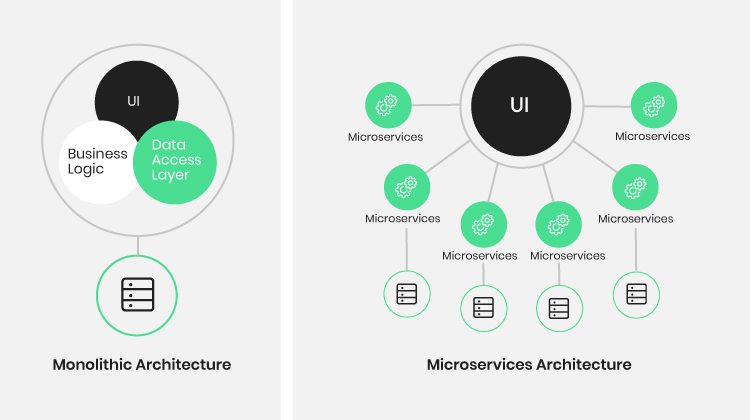Monolith or Microservices: Which Architecture Is Best for You?

Tech giants like Amazon, Google, and Netflix are moving toward microservice architectures—and where they go, most businesses usually follow.
But is a microservices architecture right for your business? The short answer is this:
- If you’re closer in size to a startup than you are to a tech behemoth, a monolithic approach will give you the most short-term advantages.
- If you’re predicting rapid growth, however, you might want to start with a microservices architecture. You won’t see immediate benefits, but it will pay off in the long term.
To understand the reasoning behind these recommendations, let’s dive into the differences between the two software architectures.
This white paper discusses what monolithic and microservices architectures are, what the differences mean for developers and product owners, and the pros and cons of each approach.
What is a Monolithic Architecture?
An application created with a monolithic architecture is built as a single unit with three distinct tiers.
There’s a data access tier, usually involving a relational database that stores and provides access to data points that are related to one another.
There’s also a browser-based, client-side user interface (UI) made up of HTML pages, JavaScript, or both.
Finally, there’s a business logic tier, which is a server-side application that handles HTTP requests, accesses the database, and sends the results to the UI.
Monolithic Architecture Pros and Cons
Because it’s built as a single, indivisible unit, monolithic applications have one big codebase. If you want to change something, you have to simultaneously make changes in the whole stack—database, UI, and server-side application.
This tight coupling can be a disadvantage when you need to scale the application, but it can help speed development for smaller applications.
Pros
- Easier development. The monolithic approach is the most common architecture for building applications. Therefore, your engineering team should have all the capabilities they need to develop a monolithic application.
- Fewer cross-cutting concerns. Cross-cutting concerns are parts of a program that rely on or must affect many other parts of a system. They’re things like logging, handling, caching, and performance monitoring. In a monolithic application, the application is self-contained for the most part, so cross-cutting is easier to handle.
- Easier debugging and testing. It’s easier to find and fix defects in monolithic architectures than it is in microservices architectures. Because a monolithic application is a single indivisible unit, you can run end-to-end testing much faster.
- Better performance. Because it has a centralized code and memory, a monolithic application can make one API call to perform a task. The same task in a microservices-based application could take several different API calls to dozens of other microservices.
Cons
- Problematic scalability. When you need to scale a monolithic application, you have to scale the whole application. You can’t scale components independently. And when a monolithic application scales up, so does its complexity. Complex code in a single, indivisible application quickly becomes tough to manage.
- Longer development time. It becomes challenging to implement changes in a large, complex application with tight coupling. Every code change affects the entire application, requiring strictly coordinated change management and extending the length of the overall development process.
- Upgrade issues. Likewise, it’s incredibly challenging to incorporate new technology into a monolithic application because you must rewrite the entire application.
When to Choose a Monolithic Architecture
A monolithic architecture might be advantageous if any of the following aspects apply to your business:
- You have a small team. Startups with small development teams can avoid the complexity of a microservices architecture. A monolithic approach should meet all your business needs.
- Your application is simple. Monolithic architectures are better suited for small applications that require little business logic, scalability, and flexibility.
- Your team lacks microservices experience. Your development team needs a lot of expertise in microservices to pull off an app that will deliver the results you want. Trying to build a microservices architecture without deep experience will likely fail.
- You want to keep costs down. If you want to keep initial costs low and quickly validate your business idea, a monolithic architecture is the way to go.
What is a Microservices Architecture?
We’ve discussed how an application built on a monolithic architecture is a single, indivisible unit. In a microservices architecture, the reverse is true: the application is a suite of small, independent services.
Each service component performs a small part of the overall functionality. Services operate independently of each other and communicate application programming interfaces (APIs).
Every service can be updated, deployed, and scaled independently, eliminating the scalability drawback of the monolithic approach. Therefore, microservices architectures are much easier to scale.
Pros
- Better scalability. As previously mentioned, each service component can be scaled independently, reducing development cost and time. There are also fewer limits to scalability than there are in monolithic architectures.
- Highly agile. A bug in one component only affects that microservice, not the whole application. Therefore, you can implement experimental changes with lower risk and fewer errors.
- Faster upgrades. Each service is its own component, so it’s easier to add new features to a microservice application than a monolithic one.
- Easier to understand. Because the service components are small and straightforward, a microservice application is easier to understand and manage.
- More flexibility. Developers aren’t handcuffed to the initial technology used to build the application. They can apply different frameworks for each microservice.
Cons
- More complexity. A microservices architecture is a distributed system. As a result, you have to establish connections between each service and database. With multiple components and databases, all connections must be handled carefully.
- Cross-cutting concerns. Because the application isn’t self-contained, you will have more cross-cutting concerns.
- Greater testing difficulty. More components mean more variables to test, increasing the difficulty and complexity of your QA efforts.
When to Choose a Microservices Architecture
A microservices architecture will benefit you if all of the following aspects apply to your business:
- You plan to develop a complex application. A microservices architecture makes it much easier to add new capabilities and scale your application. That makes it well suited to large applications with several modules and user journeys.
- Your team has a high level of expertise… You need a high level of knowledge and experience to build an application with a microservices architecture.
- … and not just in microservices. Knowing the architecture is only part of building microservices. DevOps, containers, and domain modeling are also areas in which you’ll need expertise because those functionalities are tightly interwoven with microservices.
- You have the engineering resources. A microservice application involves multiple services, and you’ll need a dedicated team for each one.
- You have the proper infrastructure. A microservices approach works best with a strong cloud-based infrastructure running on Docker or Kubernetes.
Conclusion
Although microservices architectures are gaining in popularity, monolithic architectures remain a good option for some businesses.
For example, suppose you’re a startup with a small development team, and you want to validate your business idea. In that case, you don’t need to implement microservices. A monolithic application will be easier to build, test, and deploy.
A microservices architecture is more effective when developing a complex application with different functions and services. Just be aware that without deep microservices expertise, development may be problematic and prone to failure.
What should you do if you need a microservices architecture, but your team doesn’t have the knowledge and skills necessary to build it? You could hire personnel to fill the gaps, but you’ll also need experts in DevOps, containers, and domain modeling. It will be time-consuming and expensive to hire that many engineers.
A more cost-effective way to build a microservices application is to find a software development partner that already has a team with the necessary knowledge and experience. Outsourcing microservices development is an effective strategy many businesses deploy to build and maintain software solutions with a high degree of complexity.
If outsourcing is an option you’d like to explore, Taazaa can help. To learn more, contact us.
About Taazaa
Taazaa means “fresh.” Think new. Not canned. Tailored to you. We work with like-minded people and organizations looking for a fresh experience around creating and unleashing great software.
Since 2007, Taazaa has helped hundreds of mission-minded organizations stay relevant in a world of relentless change. Leveraging custom software solutions and emerging technology, we follow design-based development practices that promote rapid delivery and a tailored fit to your business.
We’re agile. We’re high-empathy and low-friction. And we make great software.

